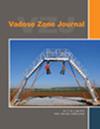加利福尼亚州内华达山脉源头集水区表土厚度趋势
IF 2.8
3区 地球科学
Q3 ENVIRONMENTAL SCIENCES
引用次数: 0
摘要
扎根于深厚的风化层使森林能够抵御季节性和年度性的降水短缺。尽管具有生态重要性,但森林生态系统中风化层厚度的空间模式几乎没有记录。在内华达山脉南部543公顷流域的66个地点,通过手动螺旋钻估计风化层厚度至破坏点或最大深度7.5米,描述了最小厚度估计值。风化层由1–2 m的土壤组成,覆盖在厚且多孔的风化花岗闪长岩上。螺旋输送器故障的深度范围从1.52到超过7.5m的不确定深度。共有27个点超过7.5m深度。正态、对数正态和伽马数据分布模型适用于观测,以推断整个流域的厚度,并估计超出测量限制的厚度。对风化层厚度第95百分位的预测变化很大;对数正态26.05米,伽马16.87米,正态9.56米。考虑到任何最佳拟合模型,55%以上的流域区域深度超过5米。形成深度等级是为了评估地形与风化层厚度空间趋势的关联程度。空间格局与两个协变指标(与河道的距离和地形湿度)有关,高地浅层深度等级(7.5m)的总体景观趋势。5年干旱后期的归一化差异植被指数特征在低地更为绿色。相比之下,高地森林表现出广泛的树木死亡,这表明深层蓄水无法维持森林长期干旱。本文章由计算机程序翻译,如有差异,请以英文原文为准。
Trends in regolith thickness in a headwater catchment, Sierra Nevada, California
Rooting in deep regolith enables forests to withstand seasonal and annual precipitation shortfalls. Despite its ecological importance, spatial patterns in regolith thickness within forest ecosystems are scarcely documented. Regolith thickness was estimated at 66 sites throughout a 543‐ha watershed in the southern Sierra Nevada by hand auger to point of failure or a maximum depth of 7.5 m, describing a minimum thickness estimate. Regolith consists of 1–2 m of soil overlying thick and porous weathered granodiorite. Depth to auger failure ranged from 1.52 to an indeterminate depth beyond 7.5 m. A total of 27 points exceeded 7.5 m depth. Normal, lognormal, and gamma data distribution models were fitted to observations to extrapolate thickness across the watershed and estimate thicknesses beyond the measurement limitation. Predictions for the 95th percentile of regolith thickness varied substantially; 26.05 m for lognormal, 16.87 m for gamma, and 9.56 m for normal. Considering any best fit model, >55% of the watershed area was deeper than 5 m. Depth classes were formed to evaluate the extent to which topography is associated with spatial trends in regolith thickness. Spatial patterns were related to two covariate proxies (distance from stream channel and topographic wetness) with the general landscape trend of shallow depth classes (<3.3 m) in lowlands and deeper regolith classes (>7.5 m) in uplands. The normalized difference vegetation index signatures over the late stages of a 5‐year drought were greener in the lowlands. In contrast, upland forests displayed widespread tree die‐off, suggesting deep water storage does not maintain forests over long‐term drought.
求助全文
通过发布文献求助,成功后即可免费获取论文全文。
去求助
来源期刊

Vadose Zone Journal
环境科学-环境科学
CiteScore
5.60
自引率
7.10%
发文量
61
审稿时长
3.8 months
期刊介绍:
Vadose Zone Journal is a unique publication outlet for interdisciplinary research and assessment of the vadose zone, the portion of the Critical Zone that comprises the Earth’s critical living surface down to groundwater. It is a peer-reviewed, international journal publishing reviews, original research, and special sections across a wide range of disciplines. Vadose Zone Journal reports fundamental and applied research from disciplinary and multidisciplinary investigations, including assessment and policy analyses, of the mostly unsaturated zone between the soil surface and the groundwater table. The goal is to disseminate information to facilitate science-based decision-making and sustainable management of the vadose zone. Examples of topic areas suitable for VZJ are variably saturated fluid flow, heat and solute transport in granular and fractured media, flow processes in the capillary fringe at or near the water table, water table management, regional and global climate change impacts on the vadose zone, carbon sequestration, design and performance of waste disposal facilities, long-term stewardship of contaminated sites in the vadose zone, biogeochemical transformation processes, microbial processes in shallow and deep formations, bioremediation, and the fate and transport of radionuclides, inorganic and organic chemicals, colloids, viruses, and microorganisms. Articles in VZJ also address yet-to-be-resolved issues, such as how to quantify heterogeneity of subsurface processes and properties, and how to couple physical, chemical, and biological processes across a range of spatial scales from the molecular to the global.
 求助内容:
求助内容: 应助结果提醒方式:
应助结果提醒方式:


